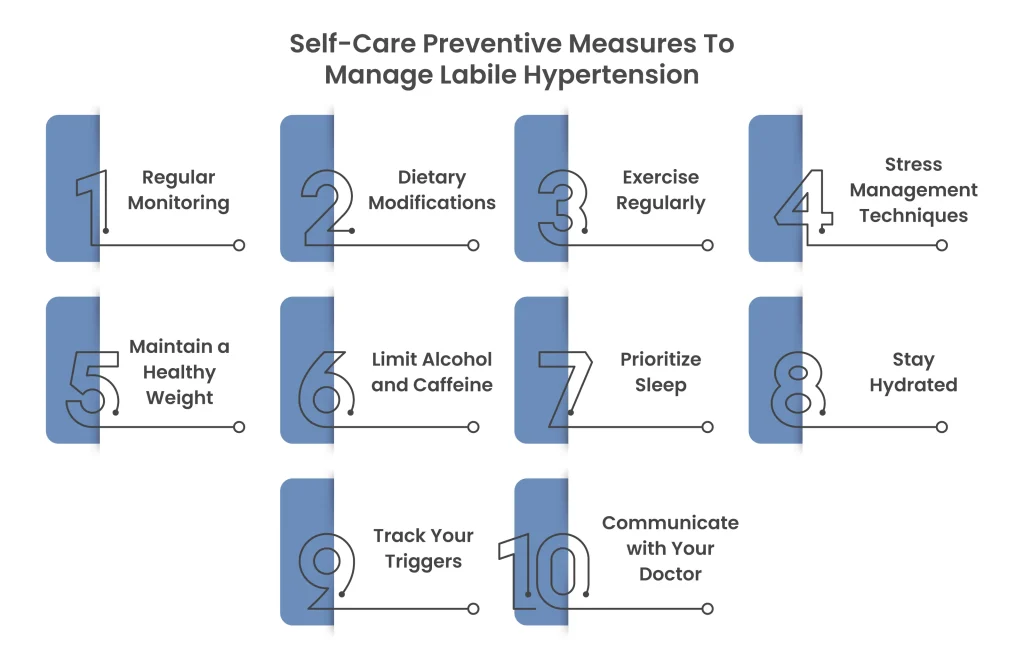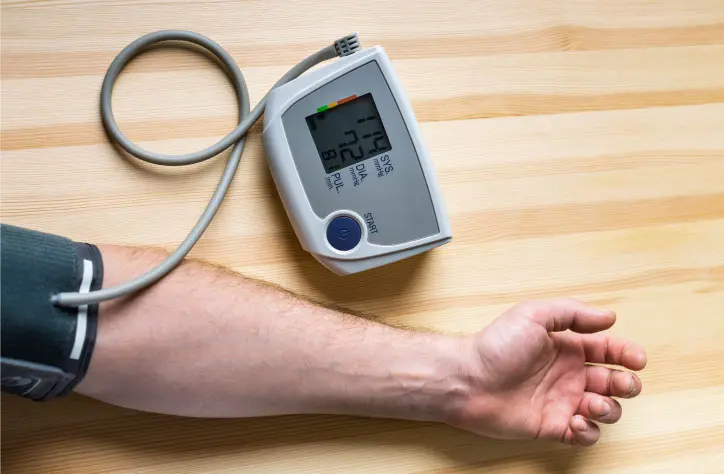Ever feel like your blood pressure has a mind of its own? One moment you’re calm and collected, the next your heart’s pounding and your head’s throbbing with a sudden spike. Then, just as quickly, everything settles down again, leaving you wondering what just happened. If this sounds familiar, you might be experiencing labile hypertension, a condition where your blood pressure swings like a pendulum.
Don’t ignore these sudden changes in your blood pressure. Over time, they can seriously damage your heart and blood vessels. Each time your blood pressure spikes, it puts extra stress on your body, raising your chances of having a heart attack, stroke, or other health problems.
But here’s the good news: labile hypertension doesn’t have to dictate your life. With the right knowledge and tools, you can tame those blood pressure swings and protect your health. This article will be your guide, shedding light on the causes, symptoms, and risks of labile hypertension, while equipping you with practical strategies to manage it and regain control of your well-being.
What Is Labile Hypertension?
Labile hypertension, also known as borderline hypertension, is a condition where your blood pressure swings rapidly between normal and high levels. Instead of staying consistently elevated, your blood pressure swings up and down throughout the day, often without warning.
So, what exactly is labile hypertension? Imagine your blood pressure as a car on a highway. With normal blood pressure, the car travels at a steady pace. But with labile hypertension, the car suddenly accelerates to high speeds, only to slam on the brakes and slow down again. These sudden changes, from normal to high and back again, can happen multiple times a day.
While it’s perfectly normal for blood pressure to fluctuate slightly throughout the day due to things like exercise, stress, or even meals, labile hypertension takes these fluctuations to the extreme. The swings are more dramatic and frequent, making it a unique type of high blood pressure that needs special attention.
What are the Signs Of Labile Hypertension?
Labile hypertension can be a bit of a sneaky condition.Sometimes, you may not even know your blood pressure is swinging up and down. However, some people do experience noticeable symptoms during these fluctuations. Here are some signs that you might be dealing with labile hypertension:
Headaches: These can range from mild to severe and may feel like a throbbing sensation in your head.
Dizziness or lightheadedness: You might feel unsteady or faint, especially when standing up quickly.
Heart palpitations: Your heart may race, flutter, or pound uncomfortably in your chest.
Flushing: You might experience a sudden warmth or redness in your face and neck.
Shortness of breath: Even without exertion, you might feel like you’re not getting enough air.
Anxiety or nervousness: Some people feel anxious or jittery during blood pressure spikes.
Prevent heart problems before they start – Schedule a preventive checkup
Contact UsSimilar Conditions To Labile Hypertension
1. White Coat Hypertension:
This is a temporary spike in blood pressure that occurs specifically in medical settings, such as a doctor’s office. The anxiety and stress of being examined can trigger a fight-or-flight response, raising blood pressure. However, once outside the medical environment, blood pressure usually returns to normal. Unlike labile hypertension, white coat hypertension doesn’t involve frequent and dramatic swings throughout the day.
2. Masked Hypertension:
This is essentially the opposite of white-coat hypertension. With masked hypertension, blood pressure readings are normal at the doctor’s office but elevated at other times. 2 This can be due to various factors, such as stress, diet, or lifestyle habits. 3 It’s important to identify masked hypertension because untreated high blood pressure can have serious consequences.
3. Paroxysmal Hypertension:
This condition involves sudden, severe spikes in blood pressure that are often accompanied by symptoms like headaches, palpitations, sweating, and anxiety. These episodes can be triggered by certain medications, tumors, or underlying medical conditions. Paroxysmal hypertension is less common than labile hypertension and typically involves more intense and shorter-lived spikes
Understanding the Differences
While these conditions share some similarities with labile hypertension, there are key differences to keep in mind:
Frequency of fluctuations: Labile hypertension involves frequent swings throughout the day, while white coat hypertension and masked hypertension are more situational. Paroxysmal hypertension involves less frequent but more severe spikes.
Triggers: Labile hypertension can be triggered by various factors like stress, diet, or underlying conditions.
White coat hypertension is specifically triggered by medical environments, while masked hypertension is more related to daily life factors. Paroxysmal hypertension often has specific triggers like medications or underlying medical issues.
Symptoms: Labile hypertension may or may not cause symptoms, while paroxysmal hypertension often involves intense symptoms during episodes.
It’s important to distinguish between these conditions because they may require different approaches to diagnosis and treatment. If you’re experiencing unusual blood pressure fluctuations, it’s crucial to consult with your doctor for proper evaluation and guidance.
Prevent heart problems before they start – Schedule a preventive checkup
Contact UsHow to Treat Labile Hypertension?
While lifestyle changes are the first line of defense, medications may be necessary to manage labile hypertension if it doesn’t respond to lifestyle modifications alone. Here are the common types of medications used:
Alpha-Blockers
These medications work by relaxing specific muscles in your blood vessels, allowing blood to flow more easily and lowering both systolic and diastolic blood pressure. Examples include doxazosin (Cardura) and prazosin (Minipress).
Beta-Blockers
Beta-blockers act by blocking the effects of adrenaline, a hormone that can raise blood pressure. By doing so, they can slow your heart rate and reduce the force with which your heart pumps blood. Examples include propranolol (Inderal) and metoprolol (Lopressor).
Calcium Channel Blockers
These medications relax and widen blood vessels, making it easier for blood to flow and subsequently lowering blood pressure. Examples include amlodipine (Norvasc) and diltiazem (Cardizem).
Diuretics
Also known as “water pills,” diuretics help your body eliminate excess salt and water. This reduces the volume of fluid in your blood vessels, which can lower blood pressure. Examples include hydrochlorothiazide (Microzide) and furosemide (Lasix).
ACE Inhibitors
ACE inhibitors block the production of angiotensin II, a hormone that narrows blood vessels. By blocking this hormone, they help relax blood vessels and lower blood pressure. Examples include lisinopril (Prinivil) and enalapril (Vasotec).
ARBs (Angiotensin II Receptor Blockers)
ARBs work similarly to ACE inhibitors by blocking the action of angiotensin II. They help relax blood vessels and lower blood pressure. Examples include losartan (Cozaar) and valsartan (Diovan).
Anti-Anxiety Medications
In cases where stress or anxiety is a significant trigger for labile hypertension, anti-anxiety medications may be prescribed. These medications can indirectly help stabilize blood pressure by addressing the underlying cause of fluctuations.
Self-Care Preventive Measures To Manage Labile Hypertension
Taking an active role in your health through self-care is crucial for managing labile hypertension and preventing complications.
Here are some effective measures you can incorporate into your daily routine:

Regular Monitoring: Invest in a home blood pressure monitor and track your readings regularly. This can help you identify patterns and triggers for fluctuations, allowing you to make necessary adjustments to your lifestyle or medications.
Dietary Modifications: Limit your sodium intake by avoiding processed foods, fast food, and salty snacks. Focus on a balanced diet rich in fruits, vegetables, whole grains, and lean protein. Consider incorporating potassium-rich foods like bananas, spinach, and sweet potatoes, as potassium can help counteract the effects of sodium on blood pressure.
Exercise Regularly: Aim for at least 30 minutes of moderate-intensity exercise most days of the week. Brisk walking, swimming, cycling, or dancing are all great options. Regular exercise helps strengthen your heart, lower blood pressure, and reduce stress.
Stress Management Techniques: Practice relaxation techniques like deep breathing exercises, meditation, yoga, or tai chi. Find activities you enjoy that help you unwind and de-stress. Consider seeking professional help if stress is a significant factor in your labile hypertension.
Maintain a Healthy Weight: If you’re overweight or obese, even a small weight loss can significantly improve your blood pressure. Talk to your doctor or a registered dietitian to develop a safe and effective weight loss plan.
Limit Alcohol and Caffeine: Both alcohol and caffeine can contribute to blood pressure fluctuations. If you choose to drink alcohol, do so in moderation (no more than one drink per day for women and two drinks per day for men). Limit your caffeine intake from coffee, tea, and energy drinks.
Prioritize Sleep: Aim for 7-8 hours of quality sleep each night. Create a relaxing bedtime routine, avoid screens before bed, and create a comfortable sleep environment.
Stay Hydrated: Drink plenty of water throughout the day. Dehydration can lead to blood volume changes, which may affect blood pressure.
Track Your Triggers: Keep a journal to track your blood pressure readings, activities, diet, and stress levels. This can help you identify patterns and triggers for fluctuations, allowing you to make necessary adjustments.
Communicate with Your Doctor: Regularly discuss your blood pressure readings, concerns, and any changes in your health with your doctor. They can provide guidance, adjust your treatment plan as needed, and help you stay on track with your self-care efforts.
Ending Note
Labile hypertension, characterized by dramatic swings in blood pressure, can pose serious risks to your heart health. While it may not always present noticeable symptoms, understanding the signs, causes, and similar conditions is crucial for timely diagnosis and management.
If you suspect you may have labile hypertension or are experiencing concerning blood pressure fluctuations, don’t hesitate to seek professional guidance. The experts at Atlantic Cardiovascular are equipped to diagnose and manage labile hypertension, helping you regain control of your health and prevent complications.







